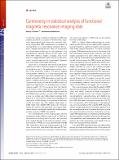Controversy in statistical analysis of functional magnetic resonance imaging data
Author(s)
Behrmann, Marlene; Brown, Emery Neal
DownloadPNAS-2017-Brown-E3368-9.pdf (506.7Kb)
PUBLISHER_POLICY
Publisher Policy
Article is made available in accordance with the publisher's policy and may be subject to US copyright law. Please refer to the publisher's site for terms of use.
Terms of use
Metadata
Show full item recordAbstract
To test the validity of statistical methods for fMRI data analysis, Eklund et al. (1) used, for the first time, large-scale experimental data rather than simulated data. Using resting-state fMRI measurements to represent a null hypothesis of no task-induced activation, the authors compare familywise error rates for voxel-based and cluster-based inferences for both parametric and nonparametric methods. Eklund et al.’s study used three fMRI statistical analysis packages. They found that, for a target familywise error rate of 5%, the parametric methods gave invalid cluster-based inferences and conservative voxel-based inferences.
Date issued
2017-04Department
Massachusetts Institute of Technology. Institute for Medical Engineering & Science; Harvard University--MIT Division of Health Sciences and Technology; Massachusetts Institute of Technology. Department of Brain and Cognitive SciencesJournal
Proceedings of the National Academy of Sciences
Publisher
National Academy of Sciences (U.S.)
Citation
Brown, Emery N., and Behrmann, Marlene. “Controversy in Statistical Analysis of Functional Magnetic Resonance Imaging Data.” Proceedings of the National Academy of Sciences 114, 17 (April 2017): E3368–E3369 © 2017 National Academy of Sciences
Version: Final published version
ISSN
0027-8424
1091-6490